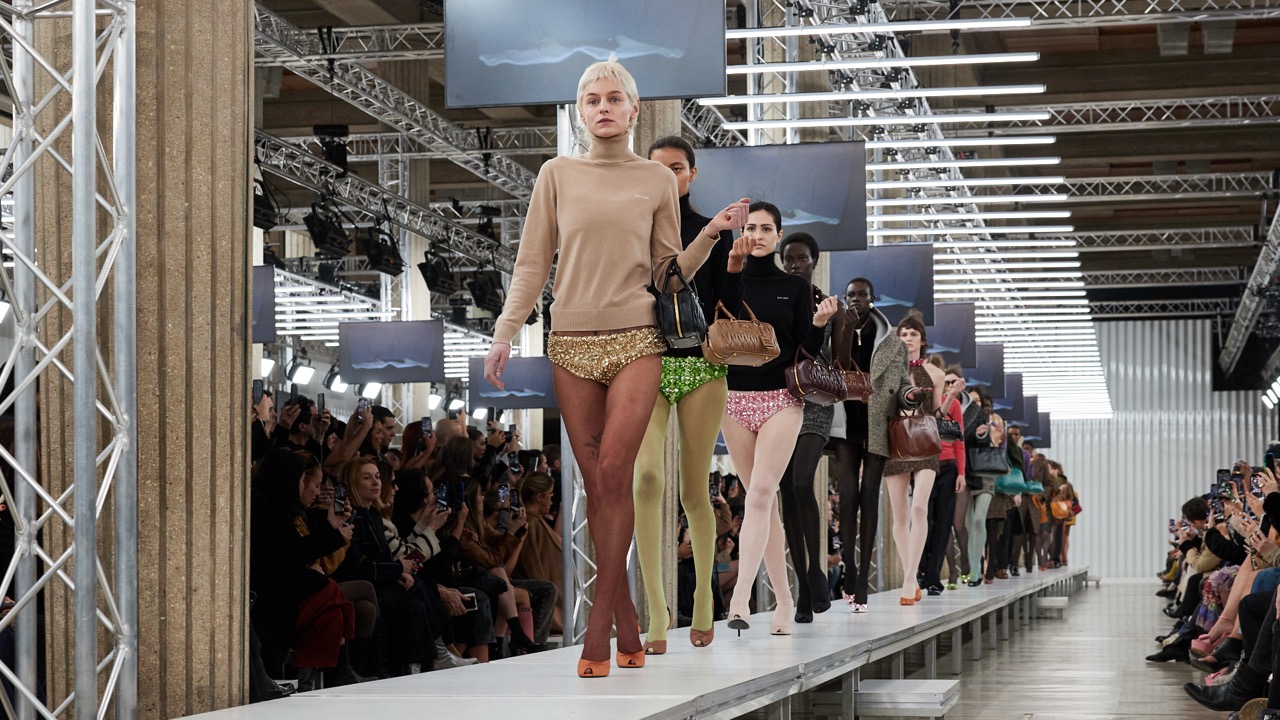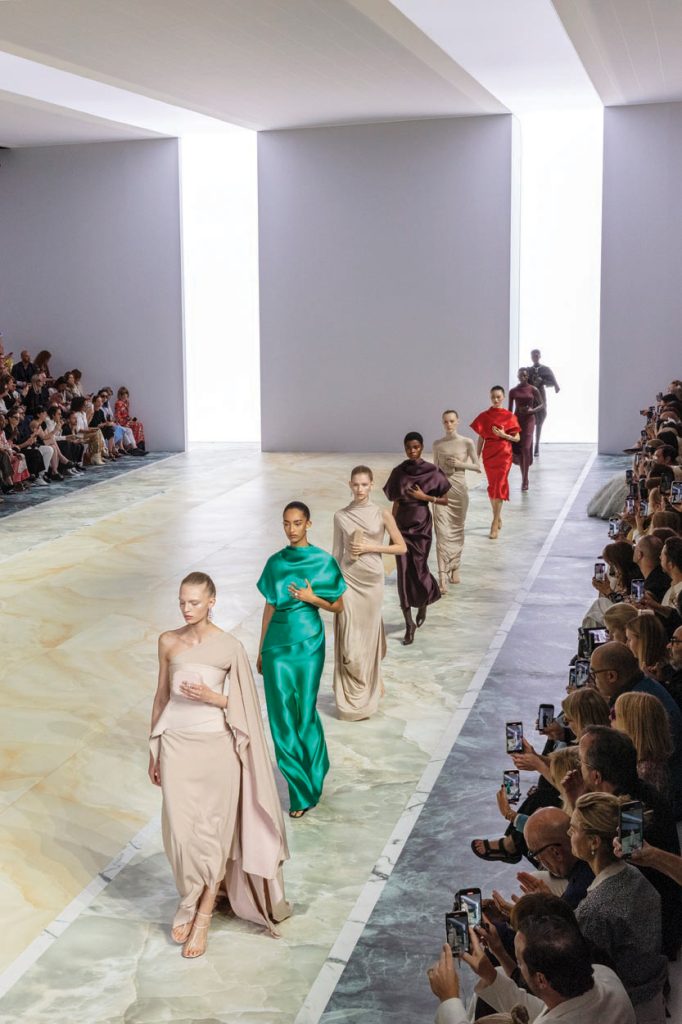
It’s no secret that the audience of this day and age has a predilection for snackable content; a meme-able image, a 10-second video clip, or a snappy 280-character tweet. The fashion world laps it up: 15 words in stark white sans serif font against an ultramarine blue square on the Style Not Com Instagram account? Hundreds of thousands read and repost within a minute. Acclaimed fashion critic Tim Blanks deems Beka Gvishiani—the mind behind Style Not Com—a “keeper of the flame”. He who unravels the fashion fandango, making approachable and accessible updates for not just the fashion nerds but also the masses. The flashcard commentaries are easily digested as it is, most often or not, a one-word description. For instance, the Fendi couture fall/winter 2023 collection was simply described as “Beautifful”—a smart and cheeky wordplay on the brand’s iconic double F logo.
The shift in content consumption is inevitable and most importantly, more favourable, but has the tilted scale gone out of hand?
Changing Of The Guard
There was a time when fashion shows were only filled with members of an exclusive circle. These included high-profile clients, fashion buyers, or prominent fashion critics like Suzy Menkes—someone capable of making or breaking a fashion designer with her scathing remarks. The critiques are sharp, precise, balanced and authentic, backed up by a great amount of contextual knowledge, minus the fear of offending their acquainted designer and affiliated partner brands. They were the trendsetters and literally, a helpful pair of eyes for the industry and an informational bridge between the greater fashion world and the general public.
The emergence of new media, however, changed the game. We entered Andy Warhol’s famous 15-minute fame era. Fashion critics were no longer the sole players on the field, as bloggers came in to give their two pence. The cohort continues to grow dramatically every season, with a banging influence mano a mano to fashion media.

“We were once described as ‘black crows’—us fashion folk gathered outside an abandoned, crumbling downtown building in a uniform of Comme de Garcons or Yohji Yamamoto … Today, the people outside fashion shows are more like peacocks than crows,” Menkes rebuked in a commentary titled The Circus of Fashion, published—ironically—on the digital site of The New York Times. The underlying elitism othered everyone else that is not from the inner circle. The statement was made on a high horse, and in some ways, obsolete. It was only a matter of time before a more diverse and progressive voice in the new media takes over as fashion, including high fashion and even haute couture, move to a comparably mainstream side of culture as the world wide web shatters walls and boundaries.
New Media, Old Problems
The outcry was that this new stream of voice is overly generic without a solid backing of relevant knowledge, making fashion commentary something frail and flash of the pan. That concern is valid, especially since most bloggers—who would later crowd the front row at fashion shows—failed to deliver constructive contributions to wholly replace the fashion critics from the old media. Many treated their blogs like a diary to showcase their perspectives, personal styles, and even private lives, in the hopes of engaging with readers on a more personal level. That approach is a double-edged sword as content is created on the premise of biases and selective perception, which defeats the purpose of fashion critics.
Sure, there will be black sheep in every herd, but there are also blogger-turned-journalists like Susanna Lau, widely known as Susie Bubble, who benefited from her blog’s presence and was given a chance to forge her way as a writer, eventually becoming a critic in the industry she’d otherwise struggled to enter since she wasn’t a member of the “black crows” clique. Unlike most full-time journalists, these bloggers are the face of their content, which heightens the relevance among their cult followers.
As the community grows, more voices are involved, and the party is merrier. Fashion consumers are exposed to various facets of fashion that go beyond runway design, from cultural appropriation to environmental concerns. The heyday of fashion blogs was brief and visuals were prioritised over words. A newer generation of critics like Luke Meagher (@hautelemode) or Mandy Lee (@oldloserinbrooklyn) would break down runway shows in layman’s terms online, whether in a two-minute Tiktok video or an hour-long podcast. Their digestable content offers people from all walks of life an opportunity to learn and eventually be a part of the conversation that was once siloed. I, for one, learned so much more about mindful fashion and its supply chain from Andrea Cheong (@dreacheong), a relatively niche part of fashion that is esoteric—something not all fashion magazines would share and reveal openly.
@andreacheong_ Reviewing these typical “quiet luxury pieces” from Massimo Dutti. Typically a decent place to find accessible premium garments (though not sustainable obv) but we still need to be wary. #quietluxury #massimodutti #howtoshopsustainably #mindfulmondaymethod #zarafashion #consciousfashion #qualityfashion ♬ original sound – Andrea
Making digital content, however, is never an easy task. Many have quit their day job to sustain their online presence. Unlike fashion critics who are paid to make content and comments, these online critics are doing it for passion’s sake. It’s understandable that many would eventually resort to brand partnering to make ends meet. This hinders the unbiasedness and authenticity as commentaries were made to please, both the audience (for numbers) and the brands (for opportunities). The lines are blurred, for better or for worse. As the pendulum swings towards a democratised sphere, what awaits on the other side is a half-pie stuffed with banality.
“There is something ridiculous about the self-aggrandisement of some online arbiters who go against the mantra that I was taught in my earliest days as a fashion journalist: ‘It isn’t good because you like it; you like it because it’s good,” Menkes reprimanded, something I personally agree with. “If Alexa Chung can write, so can everyone else,” a fashion writer friend once told me. We laughed it off bitterly. In an age where “everyone can fly”, everyone too, can write. Making fashion a welcoming space is very much needed, but who is gatekeeping as the benchmark slowly vanishes? There’s a general misconception of how “shallow” the industry is especially among the public, the last thing we need is to make it sound even simpler and heedless.
Different tunes but the same composition—if diversity was the problem among our fashion predecessors, monotonality is the current hurdle to overcome. There’s a thought-provoking piece written by Eugene Rabkin on StyleZeitgeist that raises the same question. “New media, old problem,” Rabkin concluded. Whether it’s video, audio, or caption, regardless of the format, the singularity remains—the only thing different is who’s singing this ditty. The changes throughout the decade have been progressive. Everyone can have their turn at the mic, which is more than enough to make a statement, even if you are from a different flock. Even in the old media, there are journalists and critics who speak for and from a diverse perspective. The question is, who’s reading?

Knock, Knock, Who’s There?
There’s a piece by Cathy Horyn on how Maria Grazia Chuiri’s Dior for fall/winter 2017 was nothing but a lack of surprise. I was neither a writer nor a targeted client at the time, but I could feel the dismay in her words—which is justifiable. But has Dior gone downhill from a business perspective? In the same year, the brand recorded an 11% increase (organic growth of 12%) in revenue. That got me wondering, who is reading these critiques? How relevant are they? How much will a professionally penned critique affect one’s purchase decision?
“Fashion criticism itself may still be regarded as an oxymoron: criticism is something that we apply to the arts, while fashion is resolutely located in the world of big money-spinning, glamour, power and so on… nothing to wax lyrical about for the critic, much to be cynical about instead,” reads an excerpt in the book Fashion, Writing and Criticism by Peter McNeil and Sanda Miller. Technically, fashion is art, and it’s part of the creative industry. However, fashion is also a business—there’s no contradiction between both but ultimately the numbers will gain louder hoorays.
On the other side of the door, substantial criticism is commonly in a longer form—written, video or audio, they have to be elaborate. However, consumers are inclined towards bite-sized content. Writers and content creators have eight seconds—or less—to hook readers, let alone retain them for a 10-minute read. The line-up of critics can be as competent as they want, but they will ultimately lose their relevance if they’re there just shouting into the void.
Fashion might have become something so ubiquitous and democratised, but it is still a niche sector—what more fashion criticism. After all, not everyone can spell “Gabbana”.
